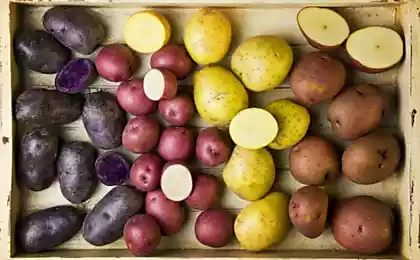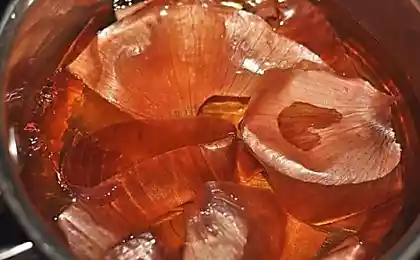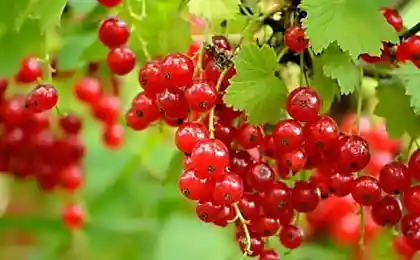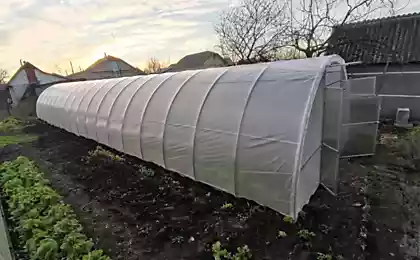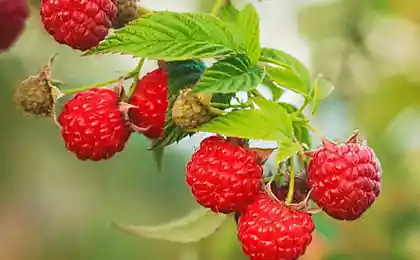562
The bow on the ridges: amazing yield!
This year we have onions in the garden has grown splendidly. The bulbs are unusually large, healthy, bright orange color, which indicates a good maturity. However, a relatively flat shape that does not quite meet its varietal characteristic. The fact that we first used the Chinese way — the onion was grown on the ridges.
Willing to share their experience
Onions are best grown after cabbage, spinach, cucumbers, zucchini, pumpkins, peas, tomatoes, salad which was made much fertilizer. If this site is not, then the fall in the garden under the bow is necessary to make 1 m 5 kg of manure humus 2 tablespoons of chalk and dig. In the spring, early or mid-April, the soil should be dug again, if it's not wet enough to pour. In each row we make the crest (can be two) with the distance between them is 30 cm, a height of 12-15 cm.
Two weeks before planting the sets or the sample is warmed near the furnace or battery at a temperature of 40-45° C for 8-10 hours. This prevents the bow from sheykovoy rot, downy mildew and strelkovanie.

Before planting, remove the scales, which during storage protects the bulb from disease, and when boarding emit into the soil substances check the growth of follicles, cut the dry part of the neck, not touching the sprout and soak for 24 hours in warm water. In the last decade of April or in early may depending on the weather and in accordance with the auspicious days of the lunar calendar, the sets are planted in ridges at a distance of 12-15 cm, buried 2-3 cm, and tightly crimp the ground around each bulblet. Two weeks after planting, feed with a solution of mullein or bird droppings, diluting it or 5 or 12 times.
If there is no rain in the first month profusely 2-3 times. Loose soil and remove weeds.
In June the bulbs are opening, algreba the soil with the ridges in the rovikah-aisle. This operation is widely used by Chinese peasants. Thanks to the warming sun and the drying of naked bulbs, and in some cases even the external roots of the stems, prevents the excretion of larvae of the onion fly, causing huge damage to crops. Open bulbs freely expand in width, therefore becoming somewhat flattened shape.
In mid-June, making the second application, directly under the root, organic or mineral fertilizer (10 liters of water 3 tablespoons of vegetable mix or 2 tablespoons superphosphate and 1 dessert spoon of potassium chloride), at a rate of 5 l per 1 m?..
A month before harvesting, do a "dry irrigation" — soil loosening. Three weeks before harvest, watering is completely stopped.
A week before cleaning, if not all the bulbs are ripe, with a spade cut the roots at a depth of 8-6 see
Remove the bow in the second half of August or first of September, given the favorable lunar days. It is very important not to be late with the cleaning, since a week and a half or so after ripening the growth of onions is resumed, and the bulbs sprout, become unfit for storage.
If after all the cleaning was late, after trimming the roots and the pen should be the bottom of the bulbs to singe over the flame. Such a bow is stored, it is quite edible, but for distillation or further planting to apply it should not be.
When onion growing on the ridges cleaning simplified: the bulbs are very easily pulled from the loose soil. So the bulbs were opened, and the roots trimmed, then land plants practically do not happen, and shake it as usually with your hands no need.
Pull the onions out on a Sunny location for a few days, and if the weather is damp, under a canopy or in the attic. After that, the pen and the remnants of roots to be cut, leaving the cervix 3-4 cm long, and bow once again dried on the stove or near any otopi tional devices. Drying at a temperature of 30-35° C allows to avoid destruction of follicles sheykovoy rot.
Onions stored in mesh bags at room temperature.
All work in the onion fields, especially the cleaning, try to execute favorable – these work days according to the lunar calendar of the gardener-gardener. I remember one year we removed the bow in cloudy weather with drizzling rain. Rustic neighbors were amazed and claimed that the onions will rot. They were removed later, on a Sunny day, but poor according to the lunar calendar. And what? Our bow was well kept until the end of July next year, and the neighbors to spring a lot of onions rotted, had to buy sets to plant. Probably all this happened because ripe onions are not on time removed and the previous rain has accelerated its secondary growth, as a result, it proved unsuitable for long term storage.
Than the preferred Chinese method of growing onions:
More efficient use of fertilizer
Simplified all agro-technical operations — weeding, watering, hoeing, opening the onions, trimming the roots
Open from the ground, the bulbs grow freely, are larger
The sun warmed the open follicles Mature faster, become an even characteristic varieties color and a nice protective coating
Drying of the bulbs prevents the excretion of the larvae of the onion fly, conducive to the healthy development of plants published
P. S. And remember, only by changing their consumption — together we change the world! © Join us at Facebook , Vkontakte, Odnoklassniki
Source: vk.com/public44431169?w=wall-44431169_320767
Willing to share their experience
Onions are best grown after cabbage, spinach, cucumbers, zucchini, pumpkins, peas, tomatoes, salad which was made much fertilizer. If this site is not, then the fall in the garden under the bow is necessary to make 1 m 5 kg of manure humus 2 tablespoons of chalk and dig. In the spring, early or mid-April, the soil should be dug again, if it's not wet enough to pour. In each row we make the crest (can be two) with the distance between them is 30 cm, a height of 12-15 cm.
Two weeks before planting the sets or the sample is warmed near the furnace or battery at a temperature of 40-45° C for 8-10 hours. This prevents the bow from sheykovoy rot, downy mildew and strelkovanie.

Before planting, remove the scales, which during storage protects the bulb from disease, and when boarding emit into the soil substances check the growth of follicles, cut the dry part of the neck, not touching the sprout and soak for 24 hours in warm water. In the last decade of April or in early may depending on the weather and in accordance with the auspicious days of the lunar calendar, the sets are planted in ridges at a distance of 12-15 cm, buried 2-3 cm, and tightly crimp the ground around each bulblet. Two weeks after planting, feed with a solution of mullein or bird droppings, diluting it or 5 or 12 times.
If there is no rain in the first month profusely 2-3 times. Loose soil and remove weeds.
In June the bulbs are opening, algreba the soil with the ridges in the rovikah-aisle. This operation is widely used by Chinese peasants. Thanks to the warming sun and the drying of naked bulbs, and in some cases even the external roots of the stems, prevents the excretion of larvae of the onion fly, causing huge damage to crops. Open bulbs freely expand in width, therefore becoming somewhat flattened shape.
In mid-June, making the second application, directly under the root, organic or mineral fertilizer (10 liters of water 3 tablespoons of vegetable mix or 2 tablespoons superphosphate and 1 dessert spoon of potassium chloride), at a rate of 5 l per 1 m?..
A month before harvesting, do a "dry irrigation" — soil loosening. Three weeks before harvest, watering is completely stopped.
A week before cleaning, if not all the bulbs are ripe, with a spade cut the roots at a depth of 8-6 see
Remove the bow in the second half of August or first of September, given the favorable lunar days. It is very important not to be late with the cleaning, since a week and a half or so after ripening the growth of onions is resumed, and the bulbs sprout, become unfit for storage.
If after all the cleaning was late, after trimming the roots and the pen should be the bottom of the bulbs to singe over the flame. Such a bow is stored, it is quite edible, but for distillation or further planting to apply it should not be.
When onion growing on the ridges cleaning simplified: the bulbs are very easily pulled from the loose soil. So the bulbs were opened, and the roots trimmed, then land plants practically do not happen, and shake it as usually with your hands no need.
Pull the onions out on a Sunny location for a few days, and if the weather is damp, under a canopy or in the attic. After that, the pen and the remnants of roots to be cut, leaving the cervix 3-4 cm long, and bow once again dried on the stove or near any otopi tional devices. Drying at a temperature of 30-35° C allows to avoid destruction of follicles sheykovoy rot.
Onions stored in mesh bags at room temperature.
All work in the onion fields, especially the cleaning, try to execute favorable – these work days according to the lunar calendar of the gardener-gardener. I remember one year we removed the bow in cloudy weather with drizzling rain. Rustic neighbors were amazed and claimed that the onions will rot. They were removed later, on a Sunny day, but poor according to the lunar calendar. And what? Our bow was well kept until the end of July next year, and the neighbors to spring a lot of onions rotted, had to buy sets to plant. Probably all this happened because ripe onions are not on time removed and the previous rain has accelerated its secondary growth, as a result, it proved unsuitable for long term storage.
Than the preferred Chinese method of growing onions:
More efficient use of fertilizer
Simplified all agro-technical operations — weeding, watering, hoeing, opening the onions, trimming the roots
Open from the ground, the bulbs grow freely, are larger
The sun warmed the open follicles Mature faster, become an even characteristic varieties color and a nice protective coating
Drying of the bulbs prevents the excretion of the larvae of the onion fly, conducive to the healthy development of plants published
P. S. And remember, only by changing their consumption — together we change the world! © Join us at Facebook , Vkontakte, Odnoklassniki
Source: vk.com/public44431169?w=wall-44431169_320767
Julia simultaneously: preserve the child's energy to his own desires!
The secrets of growing orchids: everything you need to know






